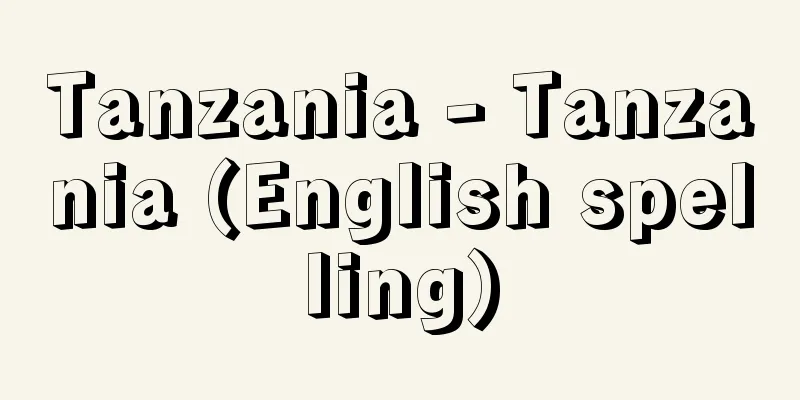Tanzania - Tanzania (English spelling)

|
A country in East Africa consisting of Tanganyika on the continent and Zanzibar (Zanzibar Island, Pemba Island, etc.) in the Indian Ocean. Its official name is the United Republic of Tanzania. It borders Kenya and Uganda to the north, Rwanda, Burundi, and the Democratic Republic of the Congo (formerly Zaire) to the west, Zambia, Malawi, and Mozambique to the south, and faces the Indian Ocean to the east. It has an area of 883,749 square kilometers and a population of 34,569,232 (2002 census). The legal capital is Dodoma, but Dar es Salaam is the de facto capital. [Ken Akasaka] NatureMost of the country is made up of plateaus over 1000 meters above sea level, with the Great Rift Valley running through the west and three lakes, Lake Victoria, Lake Tanganyika, and Lake Malawi, on its borders. High mountains such as Mount Kilimanjaro (5895 meters) and Mount Meru (4565 meters) are scattered in the northeast, and the Pare and Usambara mountain ranges run through it. The Livingstone and Kipengere mountain ranges run through the southeast. There are few large rivers, with the Pangani River, Rufiji River, and Ruvuma River flowing into the Indian Ocean. The Mara River and Kagera River flow into Lake Victoria, and the Malagarasi River flows into Lake Tanganyika. Inland rivers become dry during the dry season. The country has a tropical savanna climate with a clear distinction between the dry and rainy seasons. In Tabora on the inland plateau, the annual average temperature is 23.0°C and the annual rainfall is 952 mm, with the rainy season being from November to April. The coastal areas and Zanzibar Island have a tropical humid climate, with the annual average temperature of 25.8°C and the annual rainfall of 1,109.5 mm in Dar es Salaam. The vegetation is generally savanna, with legume trees such as acacia scattered among grassland. Evergreen forests also develop on the slopes of high mountains such as Kilimanjaro volcano, but the vertical distribution of vegetation at different altitudes is clear. Animals include herbivores such as Thomson's gazelle, wildebeest, zebra, and giraffe, and carnivores such as lions, cheetahs, African wild dogs, and jackals that chase them, as well as large mammals such as elephants, hippos, and rhinos. There are 10 national parks, including Serengeti National Park in the north, and 17 other animal sanctuaries, and 28% of the country's land area is protected by the Wildlife Protection Act. Four areas, including Kilimanjaro National Park, have been registered as natural World Heritage sites. [Ken Akasaka] historySince the discovery of the fossil human Zinjanthropus (approximately 1.8 million years ago) in the Olduai Gorge, it has been considered a stage for human evolution. The coastal region has been developed since ancient times through trade that took advantage of the Indian Ocean monsoons, and has had close ties with Arabia and Persia. As part of this, Chinese ceramics were introduced, and Tang Dynasty coins have also been excavated from Zanzibar. In the 8th century, Arabs migrated to Zanzibar and the coastal area of Kilwa, and Swahili, a local Bantu language that incorporated Arabic vocabulary, became the common language, and cities flourished with people based on Islam and Swahili culture. Since Vasco da Gama reached East Africa around the Cape of Good Hope in 1498, the Portuguese invaded the region, and in 1503 Zanzibar came under Portuguese protection. In the 18th century, the power of Muscat Oman from the Arabian Peninsula invaded the region, and started the slave trade with Kilwa as its base. In 1840, Omani Sultan Seyed Said pacified Zanzibar and established the Kingdom of Zanzibar. He further expanded his influence to the East African coast, controlling coastal cities from Mogadishu in Somalia to Kilwa in the north, and inland he established a caravan route to Ujiji on the eastern shore of Lake Tanganyika, dominating the slave trade. The Kingdom of Zanzibar, which gained independence from Oman in 1860, prospered through the trade of cloves, a spice, in addition to the slave trade. In the mid-19th century, exploration of the interior of Africa became more active, and both Britain and Germany embarked on colonizing East Africa. Germany, which joined the African colonial acquisition late, dispatched K. Peters in 1884 and obtained territory from the chief of the Usambara region. In 1886, Britain and Germany concluded an agreement, limiting the mainland territory of the Kingdom of Zanzibar to a 16-kilometer-wide coastal area, and dividing the rest between Britain in the north and Germany in the south. In 1888, Germany leased the coastal area of Zanzibar, and in 1891, the East Africa Company's territory was converted into a protectorate of the German government. Meanwhile, Britain made Zanzibar a protectorate in 1890, and in 1891 established a constitutional government with Matthews as its first prime minister. Germany introduced sisal hemp from Florida in the United States to manage the colony, and cultivated it on plantations, and also introduced coffee cultivation at the foot of the volcanic mountain Kilimanjaro. Furthermore, construction of a railway from Dar es Salaam to Lake Tanganyika was started in order to transport agricultural products. Arab and African chiefs in the coastal and inland areas had been resisting German advances since the end of the 19th century, and the Maji Maji Rebellion, which broke out in the Rufiji River basin in 1905, was the largest early resistance movement. This rebellion was sparked by dissatisfaction with Germany's forced cotton cultivation and lasted for two years, resulting in the deaths of 100,000 to 120,000 residents, before being put down by force. When World War I began, British and Belgian Congo troops occupied German East Africa, and in 1919 the Treaty of Versailles gave most of German East Africa a mandate under the League of Nations and was called Tanganyika. Tanganyika, along with Kenya and Uganda, was placed under a unified system as British East Africa, with a common currency and tariffs. In 1947 after World War II, Tanganyika became a trust territory of the United Nations, and the British established the East African High Commission, further strengthening the integration of Kenya, Uganda and Tanganyika in all fields of politics, economy and culture. However, in the 1950s, a nationalist movement developed under the leadership of J. K. Nyerere, and the Tanganyika African National Union (TANU) was formed in July 1954 and rapidly gained power. In 1955, Africans, Asians and Europeans each had an equal number of seats in the Legislative Council. In Zanzibar, the Arab Zanzibar Nationalist Party (ZNP) was founded in 1955, and the African Afro-Shiraj Party (ASP) in 1957. In the 1957 elections the ASP won a majority in the Legislative Assembly, while the Zanzibar Pemba People's Party (ZPPP), founded in 1959, took a stance in support of British policies. TANU won a landslide victory in the general elections held in September 1960, and achieved independence on December 9, 1961. The Republic of Tanganyika was established the following year on December 9, 1962, with Nyerere as its first president. In Zanzibar, a coalition government between the ZNP and ZPPP was formed in the June 1961 elections, and the country gained complete autonomy in June 1963. In December of the same year, the country gained independence as a constitutional monarchy with the Sultan as king. However, a coup occurred in January 1964, the king went into exile, and the People's Republic of Zanzibar-Pemba was established with ASP President A. A. Karume as head of state. In April 1964, Tanganyika and Zanzibar merged to form the United Republic of Tanganyika and Zanzibar. In October of the same year, the country's name was changed to the United Republic of Tanzania, with Nyerere of Tanganyika as president and Karume of Zanzibar as first vice president. [Ken Akasaka] Politics and DiplomacyKarume was assassinated in 1972, and President Nyerere established a dictatorship. Nyerere pursued a non-aligned diplomacy and maintained friendly relations with both the East and West. He had particularly close ties with China, and in 1970, with Chinese assistance, he began construction of the Tanzania-Zambia railway line, which connected Dar es Salaam with Kapiri-Mposhi in Zambia, and was completed in 1975. In February 1967, he issued the Arusha Declaration, which aimed to build a socialist society in Africa, including the nationalization of major industries. In particular, he organized Ujamaa villages modeled on Chinese people's communes, and began building rural communities. In June 1967, he also established the East African Community (EAC) with Kenya and Uganda, and began joint management of customs, transportation, and other areas. Another pillar of Tanzania's diplomacy is Pan-Africanism, and Tanzania has played a leading role as a member of the Organization of African Unity (OAU, which was reorganized as the African Union in July 2002) since its founding. The East African Community was dissolved in 1997, but was re-established in 2001 with Kenya and Uganda. Meanwhile, in February 1977, TANU and ASP merged to form the Tanzania Revolutionary Party (CCM), the only political party in Tanzania. The new constitution enacted in April of the same year proclaimed the construction of socialism under the party. The president is directly elected for a five-year term, and the parliament is unicameral with a five-year term. Zanzibar has a separate government from the mainland, and apart from foreign affairs, military, and currency, it retains extensive autonomous functions similar to those of a single state. Nyerere served as president for five terms, a total of 21 years, but announced his retirement in August 1985, and in the election held in October of the same year, his vice president, A. H. Mwinyi, was elected president. After that, socialist policies were gradually relaxed. In May 1992, a constitutional amendment introduced a multi-party system, and the following year 13 political parties had completed their registration. In October 1995, presidential and parliamentary elections were held for the first time under a multi-party system, but due to confusion in the voting, re-elections were held in Dar es Salaam and other places in November. As a result, CCM's Minister of Science, Technology and Higher Education Benjamin William Mkapa was elected as the third president in the mainland, and in Zanzibar, incumbent President Amur was re-elected by a narrow margin. In the presidential election in October 2000, Mkapa was re-elected, but CCM's Amani Karume was also elected president in Zanzibar. Because the constitution prohibits a president from serving a third term, Mkapa was replaced in the 2005 election by CCM Minister of Foreign Affairs and International Cooperation Jakaya Mrisho Kikwete, who was elected president. Karume was re-elected in Zanzibar. [Ken Akasaka] Economy and IndustryTanzania's core industries are agriculture, forestry and livestock farming, which account for 50% of the country's gross domestic product (GDP). At the time of independence, the country faced the problem of being dependent on food imports due to a dual structure of plantations and self-sufficient agriculture, and the country aimed to break away from the colonial economy and achieve food self-sufficiency by establishing collectivized farms through the Ujamaa village policy. There were more than 8,000 Ujamaa villages, and most of the farmers were organized, but bureaucracy and inadequate distribution systems meant that the efforts were ineffective, and the farmers' motivation to produce declined. In March 1983, the government acknowledged the failure of this policy and announced a new agricultural policy with the goal of food self-sufficiency. During the presidency of President Mwinyi, the country accepted the International Monetary Fund's (IMF) structural adjustment plan, and achieved an economic growth rate of 3.9% thanks to successful reforms such as reducing the budget deficit and controlling inflation. However, the trade balance in 1995 was still a large import surplus of over 860 million dollars, with exports of 682.92 million dollars and imports of 1,548.01 million dollars. Export products are mainly agricultural products such as coffee, cotton, cloves, sisal and cashew nuts. The main trading partners for exports are Germany, the UK and the Netherlands, while the UK, Germany and Japan are the main importers. Agricultural production, which supports the country's food self-sufficiency, amounted to 2,159,000 tons of corn and 59,000 tons of wheat in 1994, and is affected by drought. Mineral products include diamonds and gold, and natural gas was discovered in the Indian Ocean, which the national oil company began developing in 1980. Cloves are a specialty of the islands of Zanzibar and Pemba, and about 10,000 tons are produced annually, accounting for 70% of world production. [Ken Akasaka] Society and CultureThe population is concentrated along the Indian Ocean coast, the shores of Lake Victoria, and the foot of Mount Kilimanjaro, and the main cities include Dar es Salaam, Musoma, Mwanza, Tanga, Arusha, etc. Urbanization has not progressed overall, with the urban population accounting for only 6% of the total population. Although a decision was made to move the capital from Dar es Salaam to Dodoma, the transfer of capital functions has not progressed very far, with only the parliament moving to Dodoma in 1996 and the legislative branch being relocated. Approximately 120 tribes live in the country, with the largest Bantu-speaking agricultural group being the Sukuma, with a population of over 1 million, followed by the Nyamwezi, Makonde, Haya and Chagga, each with over 200,000. Among the Nilay-speaking groups, pastoralists such as the Masai and Datoga maintain their traditional lifestyles. Unlike Kenya, no powerful tribe dominates politics or the economy. The islands of Zanzibar and Pemba are inhabited by Arabs as well as the Shirazi, who claim to be of Persian origin. There are also Asians such as Indians and Pakistanis, as well as Somalis from Kenya and Somalia engaged in commerce. Swahili is the national language, and emphasis is placed on Swahili language education. Due to the government's emphasis on education, all education is free, and the primary school enrolment rate is 69% and the literacy rate is 68%, both of which are high among African countries. There are 42 normal schools (1991) and the University of Dar es Salaam (5,591 students) among other higher education institutions. The religion of the island and coastal areas is mostly Islam, but in the inland areas, Christianity and tribal religions are also practiced in addition to Islam. [Ken Akasaka] Relations with JapanJapan is Tanzania's third largest import partner after the UK and Germany, and in 1993 it imported $111.25 million worth of foodstuffs, automobiles, steel, machinery, etc., but exports only amounted to $41.02 million in coffee and other products, resulting in a large trade deficit for Tanzania. Economic aid from Japan amounted to $88.83 million in official development assistance in 1993, mainly for the Kilimanjaro Agricultural Development Center and the Kilimanjaro Small and Medium-sized Industrial Development Center. [Ken Akasaka] [References] | | | |Kilwa| | | | | | | | | | | | | | | | [Additional resources] |"> Tanzania flag ©Shogakukan Illustration/Shogakukan Creative "> Tanzania location map The highest peak in Africa (5,895m above sea level) is located in northeastern Tanzania. The photo shows the view from Amboseli National Park in Kenya. Tanzania, Kilimanjaro Region ©Shogakukan "> Mount Kilimanjaro Volcano A huge volcanic crater surrounded by a 600-700m-high outer rim. Part of the World Heritage Site "Ngorongoro Conservation Area" (Tanzania, 1979, registered in 2010) Tanzania, Arusha Region ©Shogakukan "> Ngorongoro Crater A canyon in the Great Rift Valley that runs between Lake Victoria and the Kilimanjaro volcano. Several fossil human bones have been discovered here. Arusha Region, Tanzania ©Shogakukan "> Oldowai Gorge Source: Shogakukan Encyclopedia Nipponica About Encyclopedia Nipponica Information | Legend |
|
東アフリカ、大陸側のタンガニーカとインド洋上のザンジバル(ザンジバル島、ペンバ島など)からなる国。正称はタンザニア連合共和国United Republic of Tanzania。北はケニア、ウガンダ、西はルワンダ、ブルンジ、コンゴ民主共和国(旧ザイール)、南はザンビア、マラウイ、モザンビークに接し、東はインド洋に面する。面積88万3749平方キロメートル、人口3456万9232(2002年国勢調査)。首都は法律上はドドマであるが、実質的に首都機能をもつのはダルエス・サラーム。 [赤阪 賢] 自然国土の大部分は標高1000メートル以上の高原からなり、西部にはアフリカ大地溝帯が走り、ビクトリア湖、タンガニーカ湖、マラウイ湖の3湖が国境線上にある。北東部にキリマンジャロ火山(5895メートル)、メルー火山(4565メートル)などの高山が点在し、パレ、ウサンバラ両山脈が走る。南東部にはリビングストン、キペンゲレ両山脈がある。大きな河川に乏しく、パンガニ川、ルフィジ川、ルブマ川などがインド洋に注いでいる。ビクトリア湖にはマラ川、カゲラ川が、タンガニーカ湖にはマラガラシ川が流入する。内陸の河川は乾期には水無川となる。 気候は、乾期と雨期との区別が明確な熱帯サバンナ気候が卓越する。内陸高原のタボラでは年平均気温23.0℃、年降水量952ミリメートルで、11月から4月が雨期となる。海岸地域やザンジバル島などは熱帯湿潤気候で、ダルエス・サラームでは年平均気温25.8℃、年降水量1109.5ミリメートルに及ぶ。 植生は一般にサバンナで、アカシアなどマメ科の樹木がイネ科の草原に点在している。キリマンジャロ火山などの高山の斜面には常緑樹林も発達するが、高度差による植生の垂直分布がはっきりしている。動物はトムソンガゼル、ワイルドビースト、シマウマ、キリンなどの草食獣と、それらを追うライオン、チーター、リカオン、ジャッカルなどの肉食獣、さらにゾウ、カバ、サイなど大形の哺乳(ほにゅう)動物がすむ。北部のセレンゲティ国立公園をはじめ10か所の国立公園が設けられ、ほかに17の動物保護区があり、国土の28%が野生動物保護法に基づく動物の保護対象地となっている。キリマンジャロ国立公園など、4か所の地域が世界遺産の自然遺産に登録されている。 [赤阪 賢] 歴史オルドワイ峡谷における化石人類ジンジャントロプス(約180万年前)の発見以来、人類進化の舞台と考えられている。海岸地域は、インド洋のモンスーンを利用した交易によって古くから開け、アラブ、ペルシアとつながりが深く、その一環として中国の陶磁器が伝えられ、ザンジバル島からは唐銭(とうせん)も出土している。8世紀にはザンジバル島や沿岸部のキルワなどにアラブ人が移住し、地元のバントゥー語にアラビア語の語彙(ごい)が取り入れられたスワヒリ語が共通語となり、イスラム教とスワヒリ文化を基調にもつ人々による都市が繁栄した。 1498年にバスコ・ダ・ガマが喜望峰を回り東アフリカに到達して以来、ポルトガル人が進出し、1503年にザンジバル島はポルトガルの保護下に置かれた。18世紀に入るとアラビア半島のマスカット・オマーンの勢力が進出し、キルワを根拠地として奴隷貿易を開始した。1840年、オマーンのスルタン、セイド・サイードは、ザンジバル島を平定しザンジバル王国をつくった。さらに、その勢力を東アフリカ沿岸部に拡大し、北はソマリアのモガディシオからキルワに至る海岸都市を支配下に置き、内陸はタンガニーカ湖東岸のウジジに至るキャラバン・ルートをつくって奴隷貿易を支配した。1860年にオマーンから独立したザンジバル王国は、奴隷貿易に加えて香辛料の丁子(ちょうじ)の貿易によって繁栄した。 19世紀なかばには、アフリカ内陸部の探検が活発になるとともに、イギリス、ドイツの両国は東アフリカの植民地化に乗り出した。アフリカの植民地獲得に遅れて参加したドイツは、1884年K・ペーテルスを派遣し、ウサンバラ地方の首長から領土を得た。1886年にはイギリスとドイツが協定を結び、ザンジバル王国の大陸部の領土は海岸地域の幅16キロメートルに限られ、残りは北部をイギリス、南部をドイツに分割した。1888年にはドイツはザンジバル領の海岸地域を租借し、1891年には東アフリカ会社の領土をドイツ政府の保護領に切り替えた。一方イギリスは、1890年ザンジバルを保護領とし、1891年にはマシューズを初代首相とする立憲政府を発足させた。ドイツは植民地経営のためサイザル麻をアメリカのフロリダから導入し、プランテーションで栽培し、またキリマンジャロ火山山麓(さんろく)ではコーヒー栽培を導入した。さらに、ダルエス・サラームからタンガニーカ湖に至る鉄道の建設に着手し、農産物の輸送を図った。ドイツの進出に対して、すでに19世紀末から沿岸部や内陸のアラブ人やアフリカ人首長は抵抗を示していたが、とくに、1905年ルフィジ川流域地方で起こったマジマジの乱は、初期の最大の抵抗運動であった。この反乱は、ドイツによるワタの強制栽培に対する不満に端を発し、10万~12万の住民の犠牲を出して2年間続いたが、武力で鎮圧された。 第一次世界大戦が始まると、イギリスおよびベルギー領コンゴの軍隊がドイツ領東アフリカを占領し、1919年のベルサイユ講和条約でドイツ領東アフリカの大部分は、イギリスの国際連盟委任統治領となり、タンガニーカとよばれることとなった。タンガニーカは、ケニア、ウガンダとともにイギリス領東アフリカとして統一的な体制下に置かれ、通貨、関税などが共通となった。第二次世界大戦後の1947年、タンガニーカは国際連合の信託統治領となり、イギリスは東アフリカ高等弁務官府を設け、政治、経済、文化の全分野で、ケニア、ウガンダ、タンガニーカの統合をいっそう強化した。しかし、1950年代には、J・K・ニエレレの指導のもとに民族主義運動が発展し、1954年7月タンガニーカ・アフリカ人民族同盟(TANU)が結成され急速に力をつけた。1955年の立法評議会ではアフリカ人、アジア人、ヨーロッパ人が、それぞれ同数の議席をもつに至った。 ザンジバルでは、1955年にアラブ系のザンジバル民族主義党(ZNP)が、1957年にはアフリカ人のアフロ・シラジ党(ASP)が結成された。1957年の選挙ではASPが立法議会の大多数の議席を獲得した。一方、1959年に結成されたザンジバル・ペンバ人民党(ZPPP)は、イギリスの政策を支持する立場をとった。 1960年9月の総選挙でTANUは大勝利を収め、1961年12月9日独立を達成した。そして翌62年12月9日、ニエレレを初代大統領とするタンガニーカ共和国が発足した。ザンジバルでは、1961年6月の選挙でZNPとZPPPとの連立政府が成立し、1963年6月に完全な自治を獲得した。ついで同年12月にはスルタンを国王とする立憲君主国として独立した。しかし1964年1月にクーデターが発生、国王は亡命し、ASPのA・A・カルメ大統領を元首とするザンジバル・ペンバ人民共和国が成立した。1964年4月、タンガニーカとザンジバルは統合し、タンガニーカ・ザンジバル連合共和国が発足、同年10月、国名をタンザニア連合共和国と改称し、大統領にはタンガニーカのニエレレ、第一副大統領にはザンジバルのカルメが就任した。 [赤阪 賢] 政治・外交1972年カルメは暗殺され、以後ニエレレ大統領の独裁体制が確立した。ニエレレは非同盟外交を展開し、東西両陣営とも友交関係を維持した。とくに中国との関係は緊密で、1970年から中国の援助でダルエス・サラームとザンビアのカピリ・ムポシを結ぶタンザン鉄道の建設に着手し、1975年に完成した。1967年2月にはアルーシャ宣言を発表し、主要産業の国有化など、アフリカにおける社会主義社会の建設を目ざした。とくに中国の人民公社をモデルにしたウジャマー村を組織し、農村共同体の建設に着手した。また1967年6月、ケニア、ウガンダとともに東アフリカ共同体(EAC)を設立し、関税、運輸などの共同経営を開始した。外交のもう一つの柱はパン・アフリカニズムであり、タンザニアはアフリカ統一機構(OAU。2002年7月アフリカ連合に改組)の創設以来のメンバーとして主導的役割を果たしている。なお、東アフリカ共同体は1997年に事実上消滅したが、2001年にケニア、ウガンダと再結成している。 一方、1977年2月TANUとASPが合併し、タンザニア革命党(CCM)がタンザニア唯一の政党として結成された。同年4月制定の新憲法では同党の下での社会主義建設をうたっている。大統領は直接選挙で選出され任期は5年、議会は一院制で任期は5年である。ザンジバルは本土とは別個の政府をもち、外交、軍事、通貨以外は単一国家に近い広範な自治機能を保持している。ニエレレは5期21年間大統領の座にあったが、1985年8月引退を表明、同年10月の選挙で副大統領のA・H・ムウィニが大統領に選出された。 その後、社会主義的政策は徐々に緩和された。1992年5月、憲法改正で複数政党制が導入され、翌年には13の政党が登録を完了した。1995年10月に大統領および国会議員の選挙が複数政党下で初めて実施されたが、投票に混乱が生じたため、11月にダルエス・サラームなどで再選挙が実施された。その結果、本土ではCCMのベンジャミン・ウィリアム・ムカパ科学技術高等教育大臣が第3代の大統領に当選、ザンジバルでは現職の大統領アムールが僅差(きんさ)で再選を果たした。2000年10月の大統領選挙でムカパは再選されたが、ザンジバルでもCCMのアマニ・カルメが大統領に当選した。 憲法で大統領の3選が禁じられているため、2005年の選挙では、ムカパは退き、CCMのジャカヤ・ムリショ・キクウェテ外務国際協力大臣が大統領に当選した。ザンジバルではカルメが再選を果たしている。 [赤阪 賢] 経済・産業タンザニアの産業の中心は農林・牧畜業であり、国内総生産(GDP)の50%を占める。独立時にはプランテーション農園と自給的農業との二重構造のなかで、食糧は輸入に依存するという問題を抱え、ウジャマー村政策による集団農場化で、植民地経済からの脱却と食糧自給を目ざした。ウジャマー村は8000を超え、ほとんどの農民を組織したが、官僚主義や流通機構の不備などで実効があがらず農民の生産意欲が低下した。 1983年3月、政府はこの政策の失敗を認め、食糧自給を目標とする新農業政策を発表した。ムウィニ大統領の時代に国際通貨基金(IMF)の構造調整計画を受け入れ、財政赤字の削減などの改革の成功や、インフレ抑制などにより3.9%の経済成長率を示した。しかしなお、貿易収支は1995年で輸出6億8292万ドル、輸入15億4801万ドルで、8億6000万ドル強の大幅な輸入超過となっている。 輸出商品は、コーヒー、ワタ、丁子、サイザル麻、カシューナッツなどの農産物が中心である。主要貿易相手国は、輸出はドイツ、イギリス、オランダ、輸入はイギリス、ドイツ、日本の順となっている。食糧自給体制を支える農業生産は、1994年にはトウモロコシ215万9000トン、小麦5万9000トンで、干魃(かんばつ)の影響を受けている。鉱産物はダイヤモンド、金などを産するほか、インド洋で天然ガスが発見され、1980年以後国営石油公社が開発に着手している。ザンジバル島、ペンバ島は丁子が特産品で、年間約1万トンを生産し世界の生産高の70%を占めている。 [赤阪 賢] 社会・文化人口はインド洋沿岸部、ビクトリア湖岸、キリマンジャロ山麓に集中しており、おもな都市はダルエス・サラームのほかに、ムソマ、ムワンザ、タンガ、アルーシャなどがあげられる。全体に都市化は進んでおらず、都市人口は全人口の6%にとどまっている。なお、首都のダルエス・サラームからドドマへの移転が決定したが、首都機能の移転はあまり進んでおらず、1996年に議会がドドマに移り、立法府が移転したにとどまっている。 国内には約120の部族が居住するが、バントゥー語系の農耕民ではスクマが最大で100万を超える人口をもつ。ついでニャムウェジ、マコンデ、ハヤ、チャガが、それぞれ20万を超える。ナイル語系では、マサイ、ダトーガなどの牧畜民が伝統的な生活様式を残している。ケニアとは異なり、有力な部族が政治、経済などで支配的地位を占めることはない。ザンジバル島やペンバ島には、アラブ人のほか、ペルシア人を起源とすると自称するシラジ人が居住している。また、インド人、パキスタン人などのアジア人や、ケニア、ソマリア出身のソマリ人が商業に従事している。 言語はスワヒリ語を国語と定め、スワヒリ語教育に力を入れている。教育に重点を置く政府の方針によって教育はすべて無償で、小学校への就学率は69%、識字率は68%に達し、アフリカ諸国では高いほうに属する。高等教育機関は師範学校42(1991)の上にダルエス・サラーム大学(学生数5591)ほかがある。宗教は島部や沿岸部はほとんどイスラム教であるが、内陸部ではイスラム教のほかにキリスト教、部族宗教も信じられている。 [赤阪 賢] 日本との関係日本はイギリス、ドイツに次ぐ第三の輸入相手国で、1993年には食糧品、自動車、鉄鋼、機械など1億1125万ドルを輸入したが、輸出はコーヒーなど4102万ドルにとどまり、タンザニアの大幅な入超である。日本からの経済援助は、1993年の政府開発援助が8883万ドルで、キリマンジャロ農業開発センターやキリマンジャロ中小工業開発などがおもなものである。 [赤阪 賢] [参照項目] | | | | | | | | | | | | | | | | | | | | [補完資料] |"> タンザニアの国旗 ©Shogakukan 作図/小学館クリエイティブ"> タンザニア位置図 タンザニア北東部にあるアフリカ大陸の最高峰(標高5895m)。写真はケニアのアンボセリ国立公園からの眺望。タンザニア キリマンジャロ州©Shogakukan"> キリマンジャロ火山 高さ600~700mの外輪山に囲まれた巨大な火山性クレーター。世界複合遺産「ンゴロンゴロ保全地域」の一部(タンザニア・1979、2010年登録) タンザニア アルーシャ州©Shogakukan"> ンゴロンゴロクレーター ビクトリア湖とキリマンジャロ火山の間を走る大地溝帯中にある峡谷。いくつもの化石人骨が発見された。タンザニア アルーシャ州©Shogakukan"> オルドワイ峡谷 出典 小学館 日本大百科全書(ニッポニカ)日本大百科全書(ニッポニカ)について 情報 | 凡例 |
<<: Tanzawa Mountains - Tanzawasanchi
>>: Search theory - Tansakuriron
Recommend
Athena Lindia (English spelling)
…Even after the settlement at the end of the 5th ...
Chirico, Giorgio de
Born: July 10, 1888, Boros [Died] November 20, 197...
Cerura vinula
An insect of the Lepidoptera, family Orthopodidae....
Bering Sea - Bering Sea (English spelling)
A closed sea area in the northernmost part of the...
Inosilicate - Inosilicate
...The number of tetrahedra in a ring can be 3, 6...
Kasei
…Each dynasty imposed a salt tax and established ...
MTN Negotiations - MTN Negotiations
…This is a large-scale multilateral trade negotia...
strip
… The cultivated land within the village was divi...
Appalachian Plateau
…The Appalachian Mountains are a peneplain formed...
Foreign currency reserves
Reserve assets held by a country's monetary a...
Mandatory provision - mandatory provision
A provision of a law that applies regardless of th...
Fixed price - fixed price
… [Monopoly behavior] Companies with monopoly pow...
Arabian Oil Co., Ltd. - Arabian Oil Co., Ltd.
Founded in 1958, it is Japan's first overseas ...
Effen, J. van - Effen
… In the following 18th century, poets and writer...
Ylang-ylang perfume - ylang-ylang perfume
…It is cultivated and used as a fragrance in vari...









